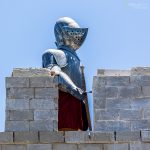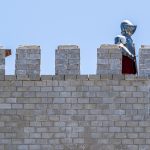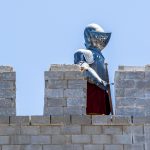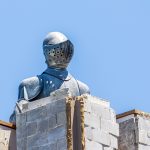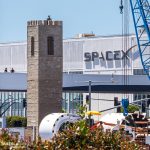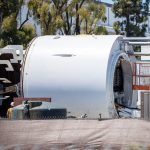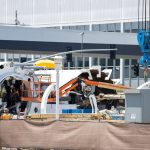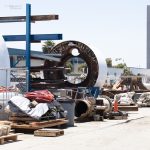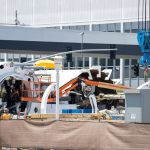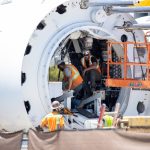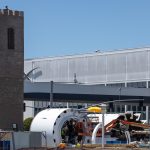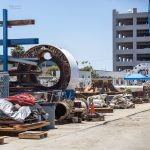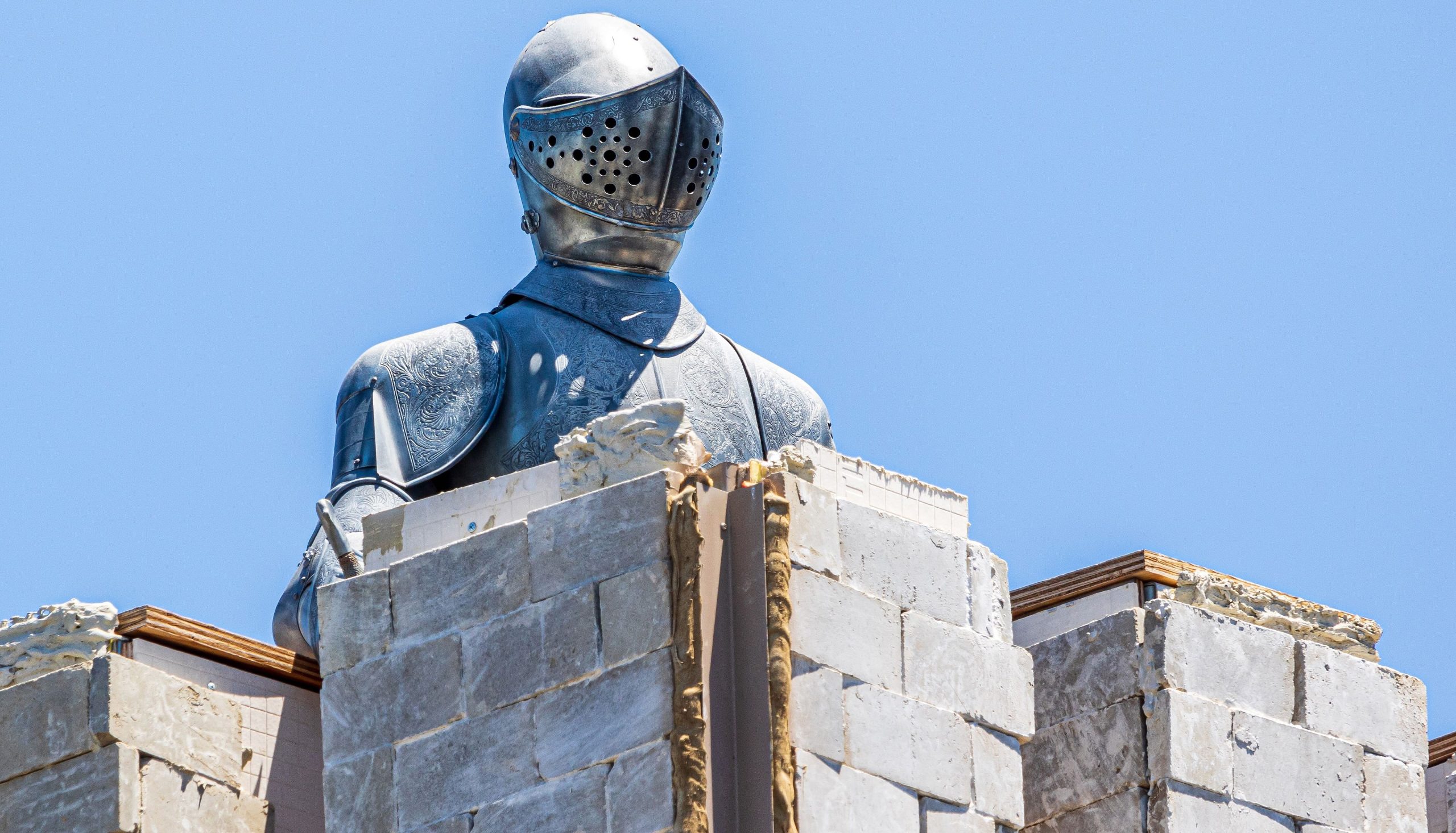

News
Elon Musk’s ‘Monty Python’ tower knight keeps watch over Boring Co’s TBM preparations
Over five months since The Boring Company held an opening party for its test tunnel in Hawthorne, CA, Elon Musk’s Monty Python-style watchtower is standing strong, and so is its occupant. Based on recent photographs taken of the site, the cleverly-built watchtower’s resident knight is still present, a lone guard watching over the Boring Company’s nearby lot and SpaceX’s headquarters.
Teslarati photographer Pauline Acalin recently paid a visit to The Boring Company’s Hawthorne site, where she was able to get some detailed shots of the ironclad sentry on his post. Pauline’s images show that the watchtower is weathering the elements pretty well, and the pre-made Boring Brick-laid sections used in the structure appear almost the same as they did during the test tunnel’s opening party. This is quite impressive, considering that the Monty Python-style watchtower was constructed in an incredibly quick manner last December.
- Elon Musk’s ‘Monty Python’ watchtower remains occupied. (Photo: Pauline Acalin/Teslarati)
- Elon Musk’s ‘Monty Python’ watchtower remains occupied. (Photo: Pauline Acalin/Teslarati)
- Elon Musk’s ‘Monty Python’ watchtower remains occupied. (Photo: Pauline Acalin/Teslarati)
- Elon Musk’s ‘Monty Python’ watchtower remains occupied. (Photo: Pauline Acalin/Teslarati)
- Elon Musk’s ‘Monty Python’ watchtower remains occupied. (Photo: Pauline Acalin/Teslarati)
- Elon Musk’s ‘Monty Python’ watchtower remains occupied. (Photo: Pauline Acalin/Teslarati)
Elon Musk’s ‘Monty Python’ watchtower remains occupied. (Photo: Pauline Acalin/Teslarati)
The Boring Company watchtower knight is a reference to one of Elon Musk’s favorite movies, Monty Python and the Holy Grail, which is widely regarded as one of the funniest movies ever made. During one of the film’s most memorable segments, a sharp-tongued French knight decided to give King Arthur and his knights a tongue-lashing for the ages. Played by actor John Cleese, the knight, as well as his creative insults, live on today, thanks to the prevalence of memes in the internet.
Apart from the watchtower knight’s continued guard duty, The Boring Company’s Hawthorne site is also seeing some notable activity. Teslarati photographer Tom Cross was able to capture several images of one of the tunneling startup’s lots in the area, which just happens to be a location where a tunnel boring machine (TBM) is being prepared.
- Elon Musk’s ‘Monty Python’ watchtower remains occupied. (Photo: Pauline Acalin/Teslarati)
- The Boring Company works on a tunnel boring machine. (Photo: Tom Cross/Teslarati)
- The Boring Company works on a tunnel boring machine. (Photo: Tom Cross/Teslarati)
- The Boring Company works on a tunnel boring machine. (Credit: Teslarati)
- The Boring Company works on a tunnel boring machine.
- The Boring Company works on a tunnel boring machine. (Photo: Tom Cross/Teslarati)
The Boring Company works on a tunnel boring machine. (Photo: Tom Cross/Teslarati)
The new tunnel boring machine is particularly noticeable due to its striking white paint. Several workers could be seen working on different sections of the TBM, though some sections of the machine placed around the lot still require some painting work. It should be noted that the TBM being prepared on the site appears very similar to Godot, the same machine used by the company to build its test tunnel. Nevertheless, Elon Musk’s previous references to its next-generation TBM, Line-Storm, triggers some speculations about the nature of the tunneling machine that Tom photographed in The Boring Company’s lot.
Teslarati has reached out to The Boring Company about this, and will update this piece once a response from the tunneling startup is received.
The Boring Company recently received a contract from the Las Vegas Convention and Visitors Authority to build a Loop System for the LVCA’s campus. The project, which will be comprised of two tunnels that will each be less than a mile long, is expected to be completed quickly. In a statement on Twitter, Elon Musk noted that the Las Vegas Loop System would likely be operational by the end of the year.
- The Boring Company works on a tunnel boring machine. (Photo: Tom Cross/Teslarati)
- The Boring Company works on a tunnel boring machine.
- The Boring Company works on a tunnel boring machine. (Photo: Tom Cross/Teslarati)
- The Boring Company works on a tunnel boring machine. (Photo: Tom Cross/Teslarati)
- The Boring Company works on a tunnel boring machine. (Photo: Tom Cross/Teslarati)
- The Boring Company works on a tunnel boring machine. (Photo: Tom Cross/Teslarati)

News
Tesla starts showing how FSD will change lives in Europe
Local officials tested the system on narrow country roads and were impressed by FSD’s smooth, human-like driving, with some calling the service a game-changer for everyday life in areas that are far from urban centers.

Tesla has launched Europe’s first public shuttle service using Full Self-Driving (Supervised) in the rural Eifelkreis Bitburg-Prüm region of Germany, demonstrating how the technology can restore independence and mobility for people who struggle with limited transport options.
Local officials tested the system on narrow country roads and were impressed by FSD’s smooth, human-like driving, with some calling the service a game-changer for everyday life in areas that are far from urban centers.
Officials see real impact on rural residents
Arzfeld Mayor Johannes Kuhl and District Administrator Andreas Kruppert personally tested the Tesla shuttle service. This allowed them to see just how well FSD navigated winding lanes and rural roads confidently. Kruppert said, “Autonomous driving sounds like science fiction to many, but we simply see here that it works totally well in rural regions too.” Kuhl, for his part, also noted that FSD “feels like a very experienced driver.”
The pilot complements the area’s “Citizen Bus” program, which provides on-demand rides for elderly residents who can no longer drive themselves. Tesla Europe shared a video of a demonstration of the service, highlighting how FSD gives people their freedom back, even in places where public transport is not as prevalent.
What the Ministry for Economic Affairs and Transport says
Rhineland-Palatinate’s Minister Daniela Schmitt supported the project, praising the collaboration that made this “first of its kind in Europe” possible. As per the ministry, the rural rollout for the service shows FSD’s potential beyond major cities, and it delivers tangible benefits like grocery runs, doctor visits, and social connections for isolated residents.
“Reliable and flexible mobility is especially vital in rural areas. With the launch of a shuttle service using self-driving vehicles (FSD supervised) by Tesla in the Eifelkreis Bitburg-Prüm, an innovative pilot project is now getting underway that complements local community bus services. It is the first project of its kind in Europe.
“The result is a real gain for rural mobility: greater accessibility, more flexibility and tangible benefits for everyday life. A strong signal for innovation, cooperation and future-oriented mobility beyond urban centers,” the ministry wrote in a LinkedIn post.
News
Tesla China quietly posts Robotaxi-related job listing
Tesla China is currently seeking a Low Voltage Electrical Engineer to work on circuit board design for the company’s autonomous vehicles.

Tesla has posted a new job listing in Shanghai explicitly tied to its Robotaxi program, fueling speculation that the company is preparing to launch its dedicated autonomous ride-hailing service in China.
As noted in the listing, Tesla China is currently seeking a Low Voltage Electrical Engineer to work on circuit board design for the company’s autonomous vehicles.
Robotaxi-specific role
The listing, which was shared on social media platform X by industry watcher @tslaming, suggested that Tesla China is looking to fill the role urgently. The job listing itself specifically mentions that the person hired for the role will be working on the Low Voltage Hardware team, which would design the circuit boards that would serve as the nervous system of the Robotaxi.
Key tasks for the role, as indicated in the job listing, include collaboration with PCB layout, firmware, mechanical, program management, and validation teams, among other responsibilities. The role is based in Shanghai.
China Robotaxi launch
China represents a massive potential market for robotaxis, with its dense urban centers and supportive policies in select cities. Tesla has limited permission to roll out FSD in the country, though despite this, its vehicles have been hailed as among the best in the market when it comes to autonomous features. So far, at least, it appears that China supports Tesla’s FSD and Robotaxi rollout.
This was hinted at in November, when Tesla brought the Cybercab to the 8th China International Import Expo (CIIE) in Shanghai, marking the first time that the autonomous two-seater was brought to the Asia-Pacific region. The vehicle, despite not having a release date in China, received a significant amount of interest among the event’s attendees.
Elon Musk
Elon Musk and Tesla AI Director share insights after empty driver seat Robotaxi rides
The executives’ unoccupied tests hint at the rapid progress of Tesla’s unsupervised Robotaxi efforts.

Tesla CEO Elon Musk and AI Director Ashok Elluswamy celebrated Christmas Eve by sharing personal experiences with Robotaxi vehicles that had no safety monitor or occupant in the driver’s seat. Musk described the system’s “perfect driving” around Austin, while Elluswamy posted video from the back seat, calling it “an amazing experience.”
The executives’ unoccupied tests hint at the rapid progress of Tesla’s unsupervised Robotaxi efforts.
Elon and Ashok’s firsthand Robotaxi insights
Prior to Musk and the Tesla AI Director’s posts, sightings of unmanned Teslas navigating public roads were widely shared on social media. One such vehicle was spotted in Austin, Texas, which Elon Musk acknowleged by stating that “Testing is underway with no occupants in the car.”
Based on his Christmas Eve post, Musk seemed to have tested an unmanned Tesla himself. “A Tesla with no safety monitor in the car and me sitting in the passenger seat took me all around Austin on Sunday with perfect driving,” Musk wrote in his post.
Elluswamy responded with a 2-minute video showing himself in the rear of an unmanned Tesla. The video featured the vehicle’s empty front seats, as well as its smooth handling through real-world traffic. He captioned his video with the words, “It’s an amazing experience!”
Towards Unsupervised operations
During an xAI Hackathon earlier this month, Elon Musk mentioned that Tesla owed be removing Safety Monitors from its Robotaxis in Austin in just three weeks. “Unsupervised is pretty much solved at this point. So there will be Tesla Robotaxis operating in Austin with no one in them. Not even anyone in the passenger seat in about three weeks,” he said. Musk echoed similar estimates at the 2025 Annual Shareholder Meeting and the Q3 2025 earnings call.
Considering the insights that were posted Musk and Elluswamy, it does appear that Tesla is working hard towards operating its Robotaxis with no safety monitors. This is quite impressive considering that the service was launched just earlier this year.

